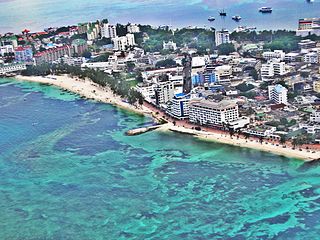San Andrés is a vibrant jewel nestled in the Caribbean, renowned for its exquisite beaches and rich, inviting culture. This Colombian island offers a unique blend of Latin and Caribbean influences, evident in its music, cuisine, and daily life. Visitors can explore the surrounding coral reef, partake in water sports, or simply relax on the sandy shores. The island’s diverse ecosystem, from its flora and fauna to the multi-colored sea, positions San Andrés as a premier destination for travelers seeking both adventure and tranquility.
Ensure to participate in the guided snorkeling tours to marvel at the vibrant marine life that makes San Andrés’ reefs a spectacular sight.
Try the local cuisine, specifically the coconut-infused dishes, to experience the authentic flavors that capture the island’s cultural heritage.
Top things to do & see in San Andrés
Select the following sights and activities to discover best tickets and tours available in San Andrés.
San Andrés: A Caribbean Gem
| Country | Colombia |
| Time in San Andrés | GMT-5 |
| Language spoken | Spanish |
| Population | 71,500 (source: latest census) |
| Currency | Colombian Peso (COP $) |
| Airports | Gustavo Rojas Pinilla International Airport (1 mi / 1.6 km). |
Situated on the Caribbean Sea, the beautiful island of San Andrés is a mesmerizing destination renowned for its exquisite beaches, rich history, and vibrant culture. Part of Colombia, yet located closer to Nicaragua, San Andrés offers a unique blend of Latin-American and Caribbean influences, making it a captivating spot for tourists seeking both adventure and relaxation.
The island’s history is steeped in tales of pirates and colonial conflicts, which have shaped its current identity and culture. San Andrés was once a haven for pirates in the 16th century and later became a key player in various geopolitical disputes in the Caribbean. Today, it proudly showcases a distinct cultural heritage known as Raizal, which includes unique music, cuisine, and traditions.
Visitors to San Andrés are greeted by its clear aquamarine waters and vibrant coral reefs, ideal for snorkeling and diving among the diverse marine life. The island’s ecological reserves, such as the Old Providence McBean Lagoon National Park, offer paths to explore coastal mangroves, reef formations, and a plethora of endemic wildlife species.
The island’s economy thrives on tourism, complemented by commercial fishing and agriculture. Its duty-free status makes it a popular shopping destination for travelers looking to buy goods at lower prices. The friendly locals and their laid-back lifestyle further enrich visitors’ experience, making San Andrés a must-visit location for those looking to immerse themselves in the Caribbean way of life.
San Andrés also hosts several cultural events throughout the year, including the Green Moon Festival, which celebrates the island’s Anglo-African heritage through music and dance, attracting visitors from around the globe.
With its sandy shores, historical richness, and cultural festivity, San Andrés remains a pearl in the Caribbean, promising unforgettable memories for anyone who steps on its shores.
Where is San Andrés?
San Andrés is a charming island in the Caribbean Sea, north of mainland Colombia.
Distances:
| Route | Distance by car | Time by car |
|---|---|---|
| Bogotá to San Andrés | 754 miles | Approx. 3 hr flight |
What is San Andrés famous for?
San Andrés is celebrated for its beautiful sandy beaches, vibrant coral reefs, and a duty-free shopping status. The island is also recognized for its eclectic blend of cultural heritages, which includes Spanish, English, and Creole influences.
History
Pre-Colonial Period (Before 1629)
Before the arrival of Europeans, the island of San Andrés was inhabited by various indigenous groups, including the Miskito and possibly other Caribbean tribes. These early inhabitants had a rich culture, primarily based on fishing and coconut farming, which had been sustained for generations on the bountiful sea surrounding them.
Founding and Spanish Rule (1629-1821)
San Andrés was officially claimed for Spain by Charles V in the early 16th century, but it was not until several decades later, in 1629, that the first Spanish settlement was initiated by Captain Morga. This period marked the beginning of significant European influence, which was characterized by the establishment of colonial infrastructure and the integration of African slaves into the island’s economy to work primarily in agriculture and pearling.
The British Period and Pirate Era (1670-1821)
During this tumultuous period, San Andrés became a haven for pirates and privateers. The strategic location of the island made it a desirable outpost for them and consequently a site of conflict between the British and Spanish empires. Notoriously, the island was at times under British control, such as during the War of Jenkins’ Ear when it was captured by Admiral Edward Vernon in 1739.
Integration into Gran Colombia and Later Colombia (1821-Present)
Following its liberation from Spanish rule, San Andrés became part of the newly formed nation of Gran Colombia in 1821, and later a part of Colombia when Gran Colombia dissolved in 1831. Throughout the 19th and 20th centuries, San Andrés experienced significant demographic and cultural changes, including establishment as a free port in 1953 and the immigration waves from mainland Colombia, which introduced diverse cultural influences that reshaped the island’s identity.
Visit San Andrés
What to see and do in San Andrés
The island of San Andrés offers a myriad of attractions and activities for visitors. Explore the vibrant coral reefs by diving or snorkeling in the clear blue waters, or lounge on the picturesque beaches like Spratt Bight or San Luis. Historical enthusiasts can visit La Casa Museo Isleña to gain insight into the island’s rich cultural history. For adventure seekers, a boat trip to nearby Johnny Cay, a small coral islet, provides stunning natural scenery and the perfect spot for an afternoon picnic.
Annual Festivals and Events in San Andrés
San Andrés is vibrant with cultural events throughout the year. The Green Moon Festival, held in September, celebrates the island’s Afro-Caribbean heritage with music, dance, and food. Also, the island comes alive during the Miss San Andrés beauty pageant in July, showcasing the charm and talent of local women amidst festive gatherings.
Best time to visit San Andrés
For ideal weather, the best time to visit San Andrés is during the dry season from December to April, when there’s less rainfall and clearer skies, perfect for outdoor activities and exploring the island’s natural beauty.
Is San Andrés worth visiting?
San Andrés is undoubtedly worth visiting for its unique blend of cultural richness and natural beauty. The island offers a variety of activities, from exploring underwater ecosystems and relaxing on sun-soaked beaches to enjoying vibrant cultural festivals. With its welcoming atmosphere and breathtaking landscapes, San Andrés provides a memorable escape for travelers seeking both adventure and relaxation in a Caribbean paradise.









